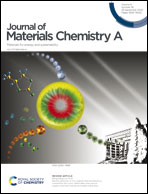In situ growth of CoP nanoparticles anchored on (N,P) co-doped porous carbon engineered by MOFs as advanced bifunctional oxygen catalyst for rechargeable Zn–air battery†
Abstract
Screening and constructing low cost, highly efficient and robust electrocatalysts with high oxygen reduction reaction (ORR) and oxygen evolution reaction (OER) activity is crucial for rechargeable metal–air batteries. Metal phosphides coupled with heteroatom doped carbon are promising candidates for oxygen electrodes. In this work, we demonstrate a facile strategy to synthesize cobalt phosphide anchored heteroatom (N,P) co-doped porous carbon (CoP/NP-HPC) through a one-step pyrolysis of bimetal–organic frameworks with a simple in situ phosphorization process. In alkaline solution, the obtained CoP/NP-HPC catalyst exhibits high bifunctional catalytic activity toward ORR and OER, comparable to commercial 20% Pt/C or even better, which is attributed to the synergistic effect between the CoP active sites and N,P co-doped carbon, and the porous framework as a channel benefiting the diffusion of reaction species. Notably, a rechargeable Zn–air battery with CoP/NP-HPC as the cathode electrocatalyst delivers a high power density of 186 mW cm−2, as well as good long-term charge/discharge cyclic stability, outperforming 20% Pt/C. The hybrid catalyst of CoP anchored heteroatom doped carbon provides a possibility and an opportunity to promote the development of low-cost and highly efficient bifunctional catalysts for ORR and OER in applications of metal–air batteries.



 Please wait while we load your content...
Please wait while we load your content...